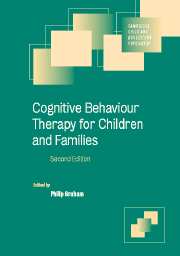Book contents
- Frontmatter
- Contents
- List of contributors
- 1 Introduction
- Part I Developmental cognitive theory and clinical practice
- Part II Engagement and assessment
- Part III Client groups
- Part IV Applications in psychosocial adversity
- Part V Applications in specific child and adolescent psychiatric disorders
- 12 Behavioural approaches to eating and sleeping problems in young children
- 13 Conduct disorders in young children
- 14 Attention deficit hyperactivity disorder
- 15 Children with developmental disabilities and their parents
- 16 Depressive disorders
- 17 Cognitive behavioural psychotherapy for obsessive compulsive disorders
- 18 Anxiety disorders
- 19 School refusal
- 20 Post-traumatic stress disorders
- 21 Disorders of eating control
- 22 Chronic fatigue syndrome
- 23 Children's interpersonal problems
- 24 Pain in childhood
- 25 Conduct disorders in adolescence
- 26 Drug and alcohol abuse
- Part VI CBT applications in preventive interventions
- Index
- References
24 - Pain in childhood
Published online by Cambridge University Press: 21 August 2009
- Frontmatter
- Contents
- List of contributors
- 1 Introduction
- Part I Developmental cognitive theory and clinical practice
- Part II Engagement and assessment
- Part III Client groups
- Part IV Applications in psychosocial adversity
- Part V Applications in specific child and adolescent psychiatric disorders
- 12 Behavioural approaches to eating and sleeping problems in young children
- 13 Conduct disorders in young children
- 14 Attention deficit hyperactivity disorder
- 15 Children with developmental disabilities and their parents
- 16 Depressive disorders
- 17 Cognitive behavioural psychotherapy for obsessive compulsive disorders
- 18 Anxiety disorders
- 19 School refusal
- 20 Post-traumatic stress disorders
- 21 Disorders of eating control
- 22 Chronic fatigue syndrome
- 23 Children's interpersonal problems
- 24 Pain in childhood
- 25 Conduct disorders in adolescence
- 26 Drug and alcohol abuse
- Part VI CBT applications in preventive interventions
- Index
- References
Summary
Introduction
The International Association for the Study of Pain has established a standard definition of pain as: ‘an unpleasant sensory and emotional experience associated with actual or potential tissue damage or described in terms of such damage’ (Merskey and Bogduk, 1994, p. 210). Cognitive behaviour therapy (CBT) has been used both to influence the presumed cause of pain (usually when the cause is related to ‘stress’) and to ameliorate the sensory and emotional aspects of pain. In this chapter, CBT will be examined in relation to both of these elements in specific pain problems.
There is a wide diversity of pain problems in children and adolescents that can be assisted by CBT. However, discussion will be focused on those problems that are common and for which there is most clinical experience and research. These include: pain from procedures, headache, recurrent abdominal pain and fibromyalgia. Similar strategies used to treat these problems can also be applied to neuropathic pain, pain from sickle cell disease, irritable bowel syndrome and pain from cancer. However, there is little research on disease-related pain interventions.
Why CBT works in pain relief
As will be discussed, there is solid evidence for the effectiveness of CBT in some areas of pain and promising evidence in others. In contrast, there is little or no evidence that simple counselling, psychodynamic or other psychotherapeutic approaches have any effectiveness in paediatric pain.
- Type
- Chapter
- Information
- Cognitive Behaviour Therapy for Children and Families , pp. 426 - 442Publisher: Cambridge University PressPrint publication year: 2004
References
- 1
- Cited by



